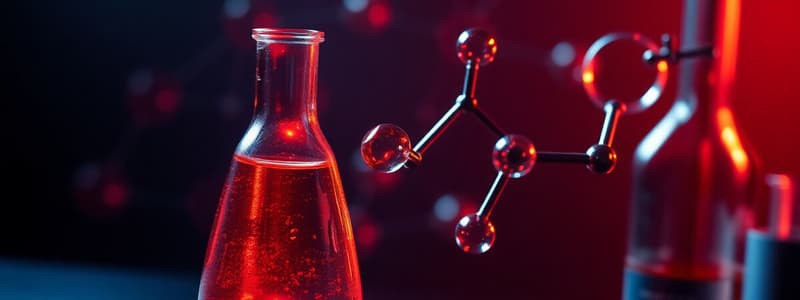Podcast
Questions and Answers
Match the descriptions to the appropriate states of molecules in a chemical reaction:
Match the descriptions to the appropriate states of molecules in a chemical reaction:
Reactants = Molecules that are thermodynamically unstable but lack sufficient energy to overcome the activation energy barrier. Transition state = The intermediate chemical stage that reactants must pass through, possessing higher free energy than initial reactants. Metastable state = Describes molecules that do not react at an appreciable rate on their own due to lack of sufficient energy. Products = The result of a chemical reaction between reactants.
Match the processes with how they overcome the activation energy barrier:
Match the processes with how they overcome the activation energy barrier:
Catalysis = Provides a reactive surface that lowers the activation energy, enhancing reaction rate without being permanently changed or consumed. Thermal Activation = Increases the kinetic energy of molecules to overcome the activation energy barrier by simply increasing the temperature of the system. Quantum Tunneling = Matter behaves as both, particle-like and wave-like properties. In dehydrogenation reactions, hydrogen atoms tunnel through the barrier effectively without exceeding it. Without intervention = Reactions do not proceed at an appreciable rate unless the energy barrier is bypassed.
Match the terms to the biological catalyst:
Match the terms to the biological catalyst:
Enzymes = Typically proteins that enhance the rate of a reaction by lowering the activation energy requirement. Active site = A specific region within an enzyme that substrates bind to and facilitates the catalytic event. Prosthetic groups = Cofactors, metal ions, or small organic molecules that are necessary for catalytic property. Ribozymes = RNA molecules with catalytic activity.
Connect the term to the proper function regarding enzyme specificity:
Connect the term to the proper function regarding enzyme specificity:
Match the enzymes with the temperature dependence:
Match the enzymes with the temperature dependence:
Match the enzymes with its pH optima:
Match the enzymes with its pH optima:
Match the terms related to enzyme function to its correct definition:
Match the terms related to enzyme function to its correct definition:
Match the terms related to active site to its best description:
Match the terms related to active site to its best description:
Match each term to the definition:
Match each term to the definition:
Match the description, with the formula:
Match the description, with the formula:
What is the meaning of ?max and Km??
What is the meaning of ?max and Km??
Match the terms with the correct description:
Match the terms with the correct description:
Match the best definition to allosteric:
Match the best definition to allosteric:
Match the descriptions to the appropriate states of molecules in a multistep enzyme reaction:
Match the descriptions to the appropriate states of molecules in a multistep enzyme reaction:
Classify the following as instances of positive cooperativity, negative cooperativity, or no cooperativity:
Classify the following as instances of positive cooperativity, negative cooperativity, or no cooperativity:
Connect the term to the description:
Connect the term to the description:
Put the enzyme in the correct catagory:
Put the enzyme in the correct catagory:
Match the definition:
Match the definition:
Match the term associated with 'ACE Inhibitors':
Match the term associated with 'ACE Inhibitors':
Relate to allosteric inhibition:
Relate to allosteric inhibition:
Match the enzymatic changes:
Match the enzymatic changes:
Match the enzyme to the step in the reaction:
Match the enzyme to the step in the reaction:
Flashcards
¿Qué es ΔG'?
¿Qué es ΔG'?
Cambio en la energía libre que indica la posibilidad y magnitud de una reacción.
¿Qué son las enzimas?
¿Qué son las enzimas?
Proteínas que actúan como catalizadores en las reacciones celulares.
¿Qué es la energía de activación (EA)?
¿Qué es la energía de activación (EA)?
La energía mínima requerida para que una reacción proceda.
¿Qué es el estado de transición?
¿Qué es el estado de transición?
Signup and view all the flashcards
¿Qué es un estado metaestable?
¿Qué es un estado metaestable?
Signup and view all the flashcards
¿Qué hace un catalizador?
¿Qué hace un catalizador?
Signup and view all the flashcards
¿Qué es la catalasa?
¿Qué es la catalasa?
Signup and view all the flashcards
¿Qué es el sitio activo?
¿Qué es el sitio activo?
Signup and view all the flashcards
¿Qué son los cofactores?
¿Qué son los cofactores?
Signup and view all the flashcards
¿Qué es la especificidad enzimática?
¿Qué es la especificidad enzimática?
Signup and view all the flashcards
¿Qué son las oxidorreductasas?
¿Qué son las oxidorreductasas?
Signup and view all the flashcards
¿Qué son las transferasas?
¿Qué son las transferasas?
Signup and view all the flashcards
¿Qué son las hidrolasas?
¿Qué son las hidrolasas?
Signup and view all the flashcards
¿Qué son las liasas?
¿Qué son las liasas?
Signup and view all the flashcards
¿Qué son las isomerasas?
¿Qué son las isomerasas?
Signup and view all the flashcards
¿Qué son las ligasas?
¿Qué son las ligasas?
Signup and view all the flashcards
Sensibilidad a la temperatura.
Sensibilidad a la temperatura.
Signup and view all the flashcards
Sensibilidad al pH
Sensibilidad al pH
Signup and view all the flashcards
Unión al sustrato.
Unión al sustrato.
Signup and view all the flashcards
Modelo de ajuste inducido.
Modelo de ajuste inducido.
Signup and view all the flashcards
Activación del sustrato.
Activación del sustrato.
Signup and view all the flashcards
¿Qué son las ribozimas?
¿Qué son las ribozimas?
Signup and view all the flashcards
¿Qué es la cinética enzimática?
¿Qué es la cinética enzimática?
Signup and view all the flashcards
Cinética de Michaelis-Menten.
Cinética de Michaelis-Menten.
Signup and view all the flashcards
¿Qué es Km (constante de Michaelis)?
¿Qué es Km (constante de Michaelis)?
Signup and view all the flashcards
Study Notes
Energia de Activación y el Estado Metastable
- La energía libre (∆G’) indica si una reacción es espontánea, pero no si ocurrirá en condiciones celulares específicas.
- La termodinámica predice si una reacción puede ocurrir, pero no determina su velocidad.
- Para que una reacción ocurra, las moléculas deben superar una barrera de energía de activación (EA).
Estados Metaestables
- La mayoría de las reacciones biológicas necesitan altas EA y las moléculas parecen estables aunque puedan ser reactivos.
- Estas moléculas están en un estado metaestable siendo termodinámicamente inestables pero sin suficiente EA para reaccionar.
- La vida depende críticamente de altas EA, que previenen que la mayoría de las reacciones celulares ocurran rápidamente sin catalizadores.
Catalizadores
- Los catalizadores aumentan la velocidad de reacción al disminuir el requerimiento de energía de activación.
- Lo hacen proveyendo una superficie reactiva que junta moléculas adyacentes, reduciendo efectivamente la energía de activación.
- Un catalizador no se consume en la reacción y simplemente facilita la interacción entre moléculas
- El "tunelamiento cuántico" es un mecanismo adicional para superar la barrera de activación.
- Basado en la dualidad onda-partícula de la materia, permite que los átomos de hidrógeno "tuneleen" a través de la barrera
- Ejemplo: descomposición del peróxido de hidrógeno (H2O2) en agua y oxígeno.
- Los iones férricos (Fe3+) y la catalasa enzimática facilitan la reacción.
Catalizadores Biológicos
- Los catalizadores comparten tres propiedades básicas:
- Aumentan la velocidad de reacción al reducir la energía de activación.
- Permiten que una reacción factible termodinámicamente ocurra a una velocidad razonable sin activación térmica.
- No alteran el equilibrio de la reacción
- No cambian la energía libre.
- Aumentan la velocidad de reacción al reducir la energía de activación.
- Actúan formando complejos reversibles con las moléculas de sustrato
- Facilita la interacción del sustrato estabilizando el estado de transición intermedio.
Enzimas
- En las células, casi toda la catálisis ocurre a través de enzimas.
- Las enzimas son moléculas orgánicas, por lo que son más específicas y regulables que los catalizadores inorgánicos.
- En general, las enzimas son proteínas, algunas moléculas de ARN llamadas ribozimas también tienen actividad catalítica.
Sitios Activos
- Las enzimas poseen un sitio activo donde los sustratos se unen y se produce la catálisis.
- El sitio activo es una hendidura o bolsillo en la proteína.
- Aminoácidos específicos no adyacentes de la secuencia primaria se juntan.
- En las reacciones facilitadas por enzimas, el sustrato se une al sitio activo de la enzima induciendo cambios estructurales en toda la molécula.
Especificidad de la Enzima
- Debido estructura del sitio activo, enzimas exhiben alto grado de especificidad de sustrato.
- Los catalizadores inorgánicos son casi siempre no específicos
- Las enzimas son mucho más específicas.
- Ejemplo: la enzima deshidrogenasa succinato cataliza la conversión de fumarato a succinato
- No puede reconocer ni siquiera al maleato (un isómero del fumarato).
- Ejemplo: la enzima deshidrogenasa succinato cataliza la conversión de fumarato a succinato
Diversidad y Nomenclatura de Enzimas
- Miles de enzimas han sido identificadas con diferentes esquemas de nombres.
- La Unión Internacional de Bioquímica creó un sistema racional para nombrar enzimas.
- Las enzimas se dividen en seis clases principales por su función general:
- Oxidoreductasas
- Transferasas
- Hidrolasas
- Liasas
- Isomerasas
- Ligasas
- A cada enzima se le asigna un número único de cuatro partes basado en su función, por ejemplo, EC 3.2.1.17 para lisozima.
Sensibilidad a la Temperatura
- La temperatura afecta a las enzimas, varía diferente según el tipo de organismo.
- Los homeotermos se definen como organismos de sangre caliente que pueden controlar la temperatura corporal independientemente del entorno.
- La velocidad de una reacción catalizada por enzimas suele aumentar con la temperatura.
- La energía cinética del enzima y de las moléculas de sustrato garantiza colisiones más frecuentes y energéticas.
- Afecta la unión del sustrato y la energía para reaccionar.
- Por encima de la temperatura crítica, el aumento adicional resulta en la desanaturación de la molécula de enzima.
- Esto provoca que pierda forma terciaria provocando la detención de la actividad catalitica.
- La disminución brusca de la actividad a temperaturas más altas refleja la desnaturalización de las moléculas enzimáticas.
- La mayoría de las enzimas pierden efectividad a temperaturas superiores a 50-55°C
Studying That Suits You
Use AI to generate personalized quizzes and flashcards to suit your learning preferences.





